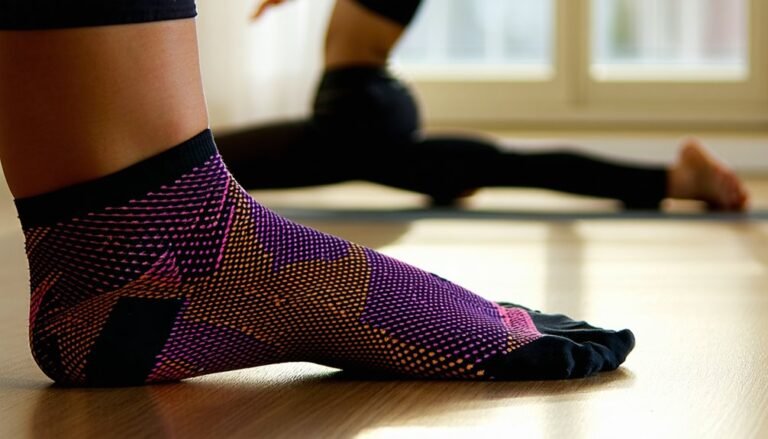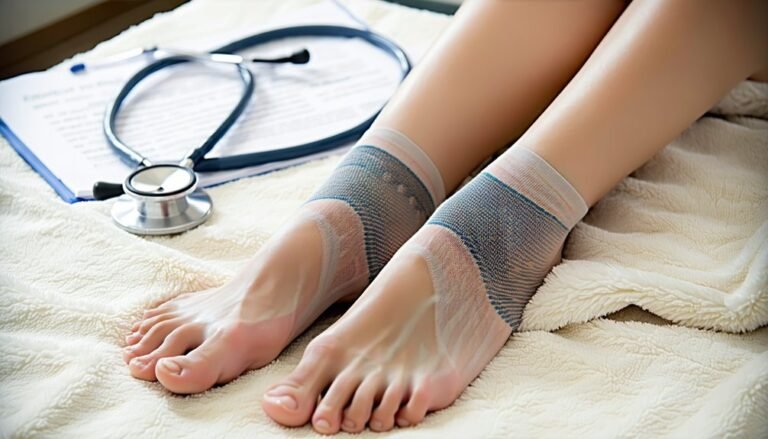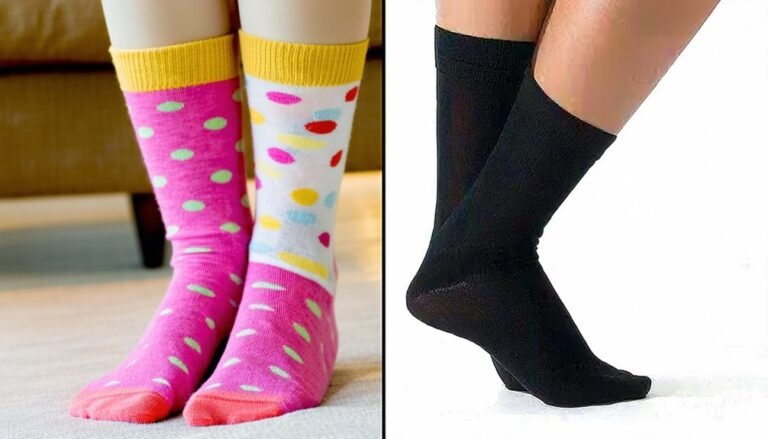Can You Sleep With a Compression Sock On?
You can sleep with a compression sock on, which enhances circulation and reduces swelling. Opt for moderate compression levels around 15-20 mmHg and choose breathable, moisture-wicking materials. Proper fit is essential, so measure your ankle and calf to guarantee the right size. Be cautious if you have conditions like peripheral artery disease, diabetes with neuropathy, or skin infections. Consult with a healthcare provider to verify it's suitable. For further insights, explore additional details ahead.
Understanding Compression Socks and Their Purpose

Compression socks, although seemingly simple, play a pivotal role in promoting venous health and preventing complications such as deep vein thrombosis (DVT). You might be curious about the various compression sock types available and their specific uses. Graduated compression socks, for instance, apply maximum pressure at the ankle, gradually decreasing up the leg, which enhances blood flow. Alternatively, uniform compression socks apply consistent pressure throughout.
When selecting the right pair, consider the compression sock materials. Options like nylon and spandex provide elasticity and durability, while cotton offers breathability. For those with sensitive skin, hypoallergenic materials are recommended. Understanding these factors guarantees you choose the correct sock type and material, optimizing safety and efficacy in managing circulatory health.
The Benefits of Wearing Compression Socks at Night
While many might wonder about the practicality of wearing compression socks at night, doing so can greatly enhance venous return and aid in the reduction of swelling. Nighttime benefits include improved circulation, which is particularly advantageous for those with venous insufficiency or edema. By gently applying pressure to your legs, these socks help your veins push blood back to your heart more efficiently, reducing swelling and discomfort.
For athletes, or those undergoing post-surgical recovery, compression socks can promote improved recovery overnight. They work by minimizing lactic acid buildup and muscle soreness, so you wake up feeling more refreshed. Additionally, they can offer comfort and support if you're standing or sitting for long periods. Always consult with a healthcare provider to ascertain they're suitable for your needs.
Potential Risks and Considerations for Nighttime Use
While compression socks can offer benefits, it's essential to be aware of potential risks like circulation impairment, especially if the socks are too tight. You might also experience skin irritation, which can be exacerbated by prolonged wear during sleep. It's important to consult with your healthcare provider to guarantee that nighttime use aligns with your specific health needs.
Circulation Impairment Concerns
Although compression socks offer numerous benefits, wearing them overnight can raise concerns about circulation impairment. If the socks are too tight, they might restrict blood flow, potentially leading to discomfort or more serious issues. It's vital to confirm that your compression socks fit properly to maintain ideal circulation health and prevent complications.
| Concern | Potential Risk | Recommendation |
|---|---|---|
| Tightness | Restricted blood flow | Choose correct size |
| Prolonged wear | Decreased circulation | Monitor usage duration |
| Improper fit | Impaired circulation | Consult healthcare provider |
Evaluating these factors is essential for safe use. If you experience numbness, tingling, or swelling, it's advisable to remove the socks immediately. Consult with a healthcare professional if uncertain about wearing compression socks overnight to confirm your safety and well-being.
Skin Irritation Risks
In addition to circulation concerns, wearing compression socks overnight may pose skin irritation risks. It's essential to understand these potential issues to guarantee your safety and comfort. If you've got skin sensitivity or a history of allergic reactions, it's wise to proceed with caution. Here are key considerations:
- Material Sensitivity: Some fabrics can trigger skin sensitivity, leading to itching or discomfort. Opt for hypoallergenic materials if you're prone to reactions.
- Moisture Accumulation: Overnight wear may trap sweat, fostering a breeding ground for irritation or fungal infections. Confirm socks are moisture-wicking.
- Continuous Pressure: Prolonged pressure may cause skin breakdown, especially in sensitive individuals. Regularly check for signs of irritation or redness.
Tips for Choosing the Right Compression Socks for Sleep
When selecting compression socks for sleep, it's essential to focus on factors that guarantee comfort and effectiveness. Opt for socks with moderate compression levels, typically 15-20 mmHg, to make certain they're gentle yet efficient. Prioritize material types that offer breathability and moisture-wicking properties to prevent skin irritation and enhance safety.
Here's a quick guide:
| Compression Level | Material Type | Benefit |
|---|---|---|
| 15-20 mmHg | Cotton Blend | Soft, breathable |
| 15-20 mmHg | Nylon/Spandex | Durable, flexible |
| 15-20 mmHg | Merino Wool | Temperature regulation |
Choose the right fit by measuring your ankle and calf circumference to avoid excessive tightness. By considering these technical aspects, you can make certain your nighttime compression socks provide the intended health benefits safely.
How to Properly Wear Compression Socks Overnight

Before you slip into bed, verifying you've properly put on your compression socks can enhance their effectiveness and comfort throughout the night. Start by focusing on the proper application:
- Choose the Right Sock Materials: Opt for breathable fabrics like nylon or spandex to reduce skin irritation and maintain comfort.
- Apply with Care: Gently roll the sock over your foot, verifying no wrinkles form, as these can impede circulation.
- Check the Fit: The sock should be snug, not too tight, to avoid cutting off circulation or causing discomfort.
Following these steps will verify that your compression socks work effectively overnight. Remember, the right technique and materials contribute considerably to improving circulation and preventing potential complications, promoting a restful night's sleep.
When to Avoid Sleeping With Compression Socks
Although compression socks can be beneficial for many, there are times when you shouldn't wear them overnight. If you have certain medical conditions or find them uncomfortable, it's wise to reconsider. Conditions like peripheral artery disease or skin infections may worsen with compression socks, potentially causing harm. Always prioritize personal comfort, as tightness could disrupt sleep quality or cause discomfort.
Here's a quick reference table:
| Medical Condition | Risk Level | Recommended Action |
|---|---|---|
| Peripheral Artery Disease | High Risk | Avoid Usage |
| Diabetes with Neuropathy | Moderate Risk | Consult Doctor |
| Skin Infections | High Risk | Avoid Usage |
| Restless Leg Syndrome | Low Risk | Assess Personal Comfort |
| Varicose Veins | Low to Moderate Risk | Use Based on Comfort Level |
Always consult a healthcare professional for tailored advice.
Frequently Asked Questions
Are There Alternatives to Compression Socks for Nighttime Leg Support?
You're wondering about alternatives for nighttime leg support. Elevating your legs with leg pillows can promote circulation and reduce swelling. This approach is safe, effective, and patient-friendly, offering relief without the potential risks of wearing compression socks overnight.
Can Wearing Compression Socks Affect My Sleep Quality?
Sleep patterns might shift subtly with snug socks, as they enhance circulation improvement. You shouldn't worry; they're generally safe. A healthcare professional can provide personalized advice to guarantee you're optimizing benefits and maintaining restful slumber.
How Do Compression Socks Impact Skin Health Overnight?
When you wear compression socks overnight, they can enhance blood circulation but might cause skin irritation if too tight. Make certain they're the correct fit to maintain skin health and prevent discomfort, focusing on safety and comfort.
Is There a Specific Time to Put on Compression Socks Before Bed?
Think of your legs as a finely-tuned orchestra requiring ideal timing for harmony. Put on compression socks 30 minutes before bedtime to seamlessly integrate them into your routine, ensuring comfort and safety as you drift into restful sleep.
Do Different Seasons Affect the Comfort of Wearing Compression Socks at Night?
Seasonal temperature and humidity levels can impact your comfort in compression socks at night. In warmer, humid conditions, you might experience increased heat retention and sweating. Guarantee proper sock selection and consult your healthcare provider for personalized advice.






